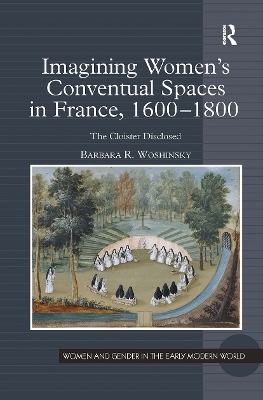
Imagining Women's Conventual Spaces in France, 1600�1800
Routledge (Verlag)
978-1-032-92114-3 (ISBN)
Blending history and architecture with literary analysis, this ground-breaking study explores the convent's place in the early modern imagination. The author brackets her account between two pivotal events: the Council of Trent imposing strict enclosure on cloistered nuns, and the French Revolution expelling them from their cloisters two centuries later. In the intervening time, women within convent walls were both captives and refugees from an outside world dominated by patriarchal power and discourses. Yet despite locks and bars, the cloister remained "porous" to privileged visitors. Others could catch a glimpse of veiled nuns through the elaborate grills separating cloistered space from the church, provoking imaginative accounts of convent life. Not surprisingly, the figure of the confined religious woman represents an intensified object of desire in male-authored narrative. The convent also spurred "feminutopian" discourses composed by women: convents become safe houses for those fleeing bad marriages or trying to construct an ideal, pastoral life, as a counter model to the male-dominated court or household. Recent criticism has identified certain privileged spaces that early modern women made their own: the ruelle, the salon, the hearth of fairy tale-telling. Woshinsky's book definitively adds the convent to this list.
Barbara Woshinsky, Professor Emerita at the University of Miami, has authored La Princesse de Clèves: the Tension of Elegance, The Linguistic Imperative in French Classical Literature and numerous articles.
Contents: Foreword; Introduction/opening; The body in early modern religious discourse (1). Hermitages of the soul: bodies as allegorical enclosures in Counter-Reformation writing; The body in early modern religious discourse (2) .Living temples or vases of ignominy: Jean-Pierre Camus and the paradoxes of female representation; Thresholds: crossing the boundaries of conventual space; Parlors: the implicated convent; Cells I: forced enclosure, erotic disclosure; Cells II: male appropriations of the nun's persona in Guilleragues’s Lettres portugaises and Diderot’s La Religieuse; Tombs/closing; Works cited; Index.
| Erscheinungsdatum | 16.10.2024 |
|---|---|
| Reihe/Serie | Women and Gender in the Early Modern World |
| Verlagsort | London |
| Sprache | englisch |
| Maße | 156 x 234 mm |
| Gewicht | 666 g |
| Themenwelt | Geisteswissenschaften ► Geschichte |
| Geisteswissenschaften ► Religion / Theologie | |
| Geisteswissenschaften ► Sprach- / Literaturwissenschaft ► Anglistik / Amerikanistik | |
| Geisteswissenschaften ► Sprach- / Literaturwissenschaft ► Literaturwissenschaft | |
| ISBN-10 | 1-032-92114-5 / 1032921145 |
| ISBN-13 | 978-1-032-92114-3 / 9781032921143 |
| Zustand | Neuware |
| Haben Sie eine Frage zum Produkt? |
aus dem Bereich


